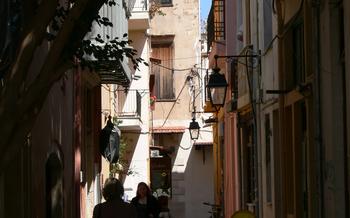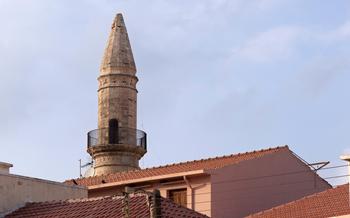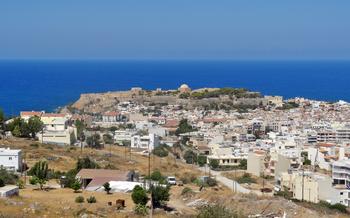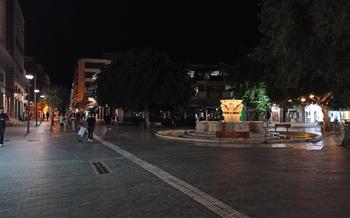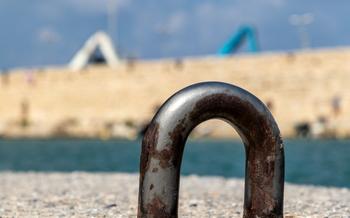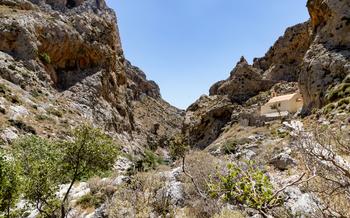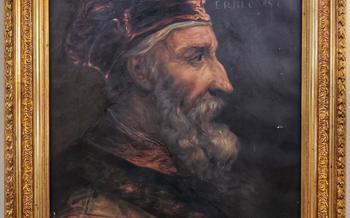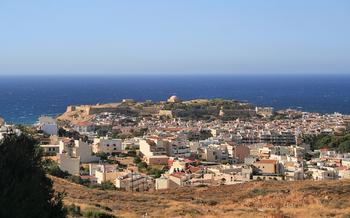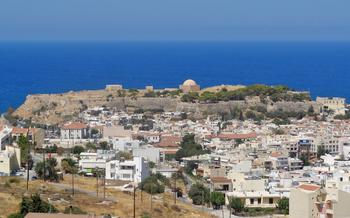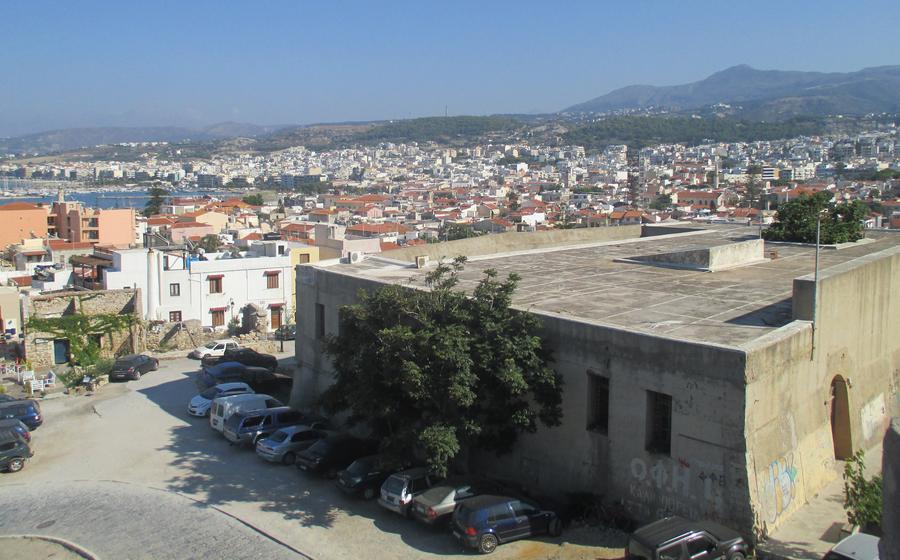
The Archaeological Museum of Rethymno
- History of the Archaeological Museum of Rethymno
- Location and Accessibility
- Exhibits and Collections
- Minoan Civilization
- Greek and Roman Antiquities
- Byzantine and Venetian Art
- Ottoman Artifacts
- Temporary Exhibitions and Events
- Guided Tours and Educational Programs
- Museum Shop and Café
- Accessibility and Visitor Facilities
- Photography and Social Media
- Opening Hours and Admission
- Insider Tip
History of the Archaeological Museum of Rethymno
Rethymno, a pearl of Crete, boasts a rich history that dates back to antiquity. During the Minoan and Mycenaean periods, the region flourished, leaving behind a legacy of ancient ruins and artifacts. The city's strategic location on the northern coast of Crete made it a coveted prize, and over the centuries, it has been ruled by various civilizations, each leaving their unique imprint. The Venetians, who arrived in the 13th century, fortified the city and constructed impressive buildings, transforming Rethymno into a thriving center of trade and culture. However, their reign ended in the 17th century, when the Ottomans conquered Crete and held it for over two centuries. During this period, Rethymno retained its importance as a major port.
In the late 19th century, as Crete struggled for independence, Rethymno played a significant role. The city's Archaeological Museum, established in 1887, stands as a testament to the region's rich cultural heritage and its resilience throughout history. The museum's collection, housed in a beautiful Venetian building, showcases artifacts from all periods of Rethymno's past, providing visitors with a glimpse into the city's fascinating journey through time.
Location and Accessibility
The Archaeological Museum of Rethymno is strategically positioned in the heart of the city, just a stone's throw from the picturesque Venetian harbor. Its exact address is Eleftheriou Venizelou 27, and it can be easily found on any map of Rethymno.
Reaching the museum is a breeze, whether you choose to stroll through the charming cobbled streets or utilize public transportation. Multiple bus routes stop nearby, making it convenient for visitors arriving from different parts of the city or surrounding areas.
For those who prefer the comfort of their own vehicle, there are ample parking options in the vicinity. Several public parking lots and on-street parking spaces are available, although fees may apply.
Exhibits and Collections
The Archaeological Museum of Rethymno boasts a diverse collection of artifacts and relics that provide a comprehensive overview of the region's rich history. One of the highlights of the museum is its collection of prehistoric artifacts from the Minoan and Mycenaean periods. These artifacts offer a glimpse into the lives and culture of these ancient civilizations that flourished in Crete. Visitors can admire intricate pottery, tools, weapons, and jewelry that showcase the advanced craftsmanship and artistic skills of the Minoans and Mycenaeans.
Another section of the museum is dedicated to Greek and Roman antiquities. Here, visitors can marvel at a collection of well-preserved sculptures, pottery, and coins that provide insight into the classical period of Greece and Rome. The museum also houses an impressive collection of Byzantine and Venetian art, including icons, frescoes, and religious objects. These artifacts offer a glimpse into the artistic traditions and cultural influences that shaped Rethymno during the Byzantine and Venetian periods.
The museum's collection also includes artifacts from the Ottoman era, providing a window into the daily life and culture of the Ottoman Empire. Visitors can examine documents, weapons, and household objects that shed light on the Ottoman period's administrative, military, and social aspects. These artifacts offer a fascinating glimpse into the history and heritage of Rethymno under Ottoman rule.
Minoan Civilization
The Archaeological Museum of Rethymno houses a remarkable collection of artifacts from the Minoan civilization, one of the most advanced and influential civilizations of the Bronze Age. The Minoans, who flourished on Crete from around 2000 to 1450 BC, were known for their impressive palaces, intricate pottery, and vibrant frescoes.
Among the highlights of the Minoan collection are the famous gold signet rings with intricate designs depicting mythical creatures and scenes from Minoan life, as well as the clay tablets inscribed with the mysterious Linear A script that has yet to be fully deciphered.
The museum also features an impressive collection of Minoan pottery, showcasing the artistry and technical skill of Minoan craftsmen. The pottery includes a variety of shapes and sizes, from delicate cups to large storage jars, and is often decorated with intricate patterns and motifs.
The Minoan civilization played a significant role in the development of ancient Greece, and its legacy can still be seen in the culture and traditions of Crete. The artifacts in the Archaeological Museum of Rethymno offer a glimpse into this fascinating civilization, providing valuable insights into its history, art, and daily life.
Greek and Roman Antiquities
The Archaeological Museum of Rethymno houses a significant collection of Greek and Roman antiquities, offering a glimpse into the rich cultural heritage of these ancient civilizations. Among the notable exhibits are exquisite sculptures, intricately decorated pottery, and a variety of coins.
The Greek sculptures include impressive marble statues, such as the Archaic Apollo, dating back to the 6th century BC, and the Romanesque Aphrodite, a finely carved representation of the goddess of beauty. The collection also features an array of pottery, including elegant vases, amphorae, and drinking vessels, showcasing the artistic prowess and technical skill of ancient Greek artisans.
The museum's Roman collection includes well-preserved mosaics, depicting scenes from mythology and everyday life. These mosaics provide valuable insights into the Roman period in Rethymno, revealing the influence of Roman culture and the integration of the city into the broader Roman Empire.
The Greek and Roman artifacts in the Archaeological Museum of Rethymno offer a profound connection to the past, allowing visitors to appreciate the artistic achievements, cultural traditions, and historical significance of these ancient civilizations.
Byzantine and Venetian Art
The Byzantine and Venetian periods left a profound impact on the artistic landscape of Rethymno. The museum houses a remarkable collection of Byzantine icons, frescoes, and other religious artifacts, showcasing the city's rich spiritual heritage. These works of art are characterized by their vibrant colors, intricate details, and deep spiritual symbolism.
Among the highlights of the Byzantine collection are several well-preserved wall paintings depicting biblical scenes and saints. These frescoes offer a glimpse into the artistic and religious traditions of the Byzantine Empire, which ruled Crete from the 5th to the 13th century.
The Venetian period brought a new wave of artistic influence to Rethymno. Venetian artists introduced new techniques and styles, incorporating elements of the Renaissance and Gothic periods. The museum's collection includes paintings, sculptures, and decorative arts from this period, demonstrating the city's vibrant cultural exchange with the wider Mediterranean world.
One of the most striking examples of Venetian art in the museum is a large altarpiece depicting the Virgin Mary and Child with saints. The intricate details and vivid colors of this masterpiece reflect the skill and artistry of Venetian craftsmen.
The evolution of artistic styles and techniques from the Byzantine to the Venetian period is a fascinating journey through the history of Rethymno. The museum's collection provides a comprehensive overview of this artistic transformation, allowing visitors to trace the development of Crete's visual culture over several centuries.
Ottoman Artifacts
The Archaeological Museum of Rethymno also houses a significant collection of artifacts from the Ottoman period, which lasted for over four centuries on Crete. These items provide insights into the daily life and culture of the Ottoman era. Among the highlights are documents, weapons, and household objects such as pottery, textiles, and metalwork. These artifacts illustrate the influence of Ottoman culture on the island and its people.
One particularly interesting artifact is a collection of Ottoman coins that were minted in Rethymno during the 17th century. These coins feature various designs and inscriptions that provide valuable information about the economic and political conditions of the time. Another notable exhibit is a collection of Ottoman weapons, including swords, daggers, and maces. These weapons showcase the military prowess of the Ottoman Empire and the importance of Rethymno as a strategic military outpost.
Overall, the Ottoman artifacts in the Archaeological Museum of Rethymno offer a glimpse into a period of significant cultural and historical change on Crete. They provide visitors with a deeper understanding of the island's rich and diverse past.
Temporary Exhibitions and Events
The Archaeological Museum of Rethymno hosts a variety of temporary exhibitions throughout the year, showcasing specific themes, artists, or archaeological discoveries. These exhibitions offer a fresh perspective on the museum's collection and provide visitors with an opportunity to delve deeper into the history and culture of Crete.
The duration of these exhibitions varies, typically lasting for a few weeks or months. They often feature artifacts from the museum's own collection, as well as loans from other museums or institutions. The museum also organizes special events, lectures, and workshops in conjunction with these exhibitions, providing visitors with a chance to engage with experts and learn more about the featured topics.
Temporary exhibitions are a great way to experience something new and exciting at the Archaeological Museum of Rethymno. They offer a chance to see different artifacts, learn about new research, and gain a deeper understanding of the rich history and culture of Crete.
Guided Tours and Educational Programs
The Archaeological Museum of Rethymno offers guided tours in several languages, including English, French, German, and Spanish. These tours are led by experienced and knowledgeable guides who provide insights into the museum's exhibits and their historical context. Guided tours typically last for about an hour and are available at a small additional fee.
In addition, the museum has a range of educational programs for schools and groups. These programs are designed to engage students with the museum's exhibits and teach them about the history and culture of Rethymno and Crete. The programs can be tailored to specific age groups and interests, and include activities such as hands-on workshops, interactive quizzes, and storytelling sessions.
Whether you are a casual visitor or a group looking for a more in-depth experience, the guided tours and educational programs at the Archaeological Museum of Rethymno are an excellent way to learn more about the rich history and culture of this fascinating region.
Museum Shop and Café
The Archaeological Museum of Rethymno also features a well-stocked museum shop where visitors can purchase a variety of souvenirs and museum-related items. From postcards and magnets to replicas of ancient artifacts and traditional Cretan handicrafts, the museum shop offers a wide range of options for those looking to take home a piece of their visit.
The museum shop also has a selection of books, postcards, and educational materials that provide a deeper insight into the history and culture of Rethymno and Crete. For those who prefer to enjoy a quick bite or refreshment, the museum also has a café offering snacks, drinks, and light meals. The café provides a pleasant and relaxing atmosphere to take a break from exploring the museum's exhibits and soak up the ambiance of the historic building.
Accessibility and Visitor Facilities
The Archaeological Museum of Rethymno is committed to providing a welcoming and accessible environment for all visitors. The museum is fully wheelchair accessible, with ramps, lifts, and wide doorways throughout the building. Accessible restrooms are also available on each floor.
For visitors who need additional assistance, the museum offers a variety of services. Audio guides are available in several languages, and staff members are always happy to provide assistance or answer questions. Visitors can also request a sign language interpreter or a tour guide who is trained to work with visitors with disabilities.
The museum also offers a number of amenities to make your visit more enjoyable. Lockers are available to store your belongings, and a café is located on the ground floor, serving snacks, drinks, and light meals. A museum shop is also located on the ground floor, where you can purchase souvenirs, books, and educational materials.
Photography and Social Media
Photography is generally allowed inside the Archaeological Museum of Rethymno, but certain restrictions may apply to protect sensitive artifacts or prevent the use of flash photography. It's always a good idea to ask a museum staff member if you're unsure about whether or not you can take pictures.
The museum actively encourages visitors to share their experiences on social media. Use the official hashtags or tag the museum's social media accounts to connect with others who are passionate about history and culture. Share your photos, thoughts, and impressions of the museum's collection and exhibitions.
The museum's Facebook, Instagram, and Twitter accounts offer a variety of content, including behind-the-scenes glimpses, highlights from the collection, and announcements about upcoming events and exhibitions. Follow the museum on social media to stay up-to-date with the latest news and to see what other visitors are saying.
Opening Hours and Admission
The Archaeological Museum of Rethymno is open to the public during the following hours:
- Tuesday to Sunday: 08:00 to 15:00
- Closed on Mondays
Admission fees are as follows:
- Full price ticket: €6
- Reduced ticket (students, seniors, military personnel): €3
- Free admission for children under 18 and EU citizens over 65
Online ticketing and reservations are available on the museum's official website. This is a convenient option to avoid any queues, especially during peak tourist season.
Insider Tip:
To enjoy a quieter and more personalized experience, it is recommended to visit the museum early in the morning or late in the afternoon, when there are fewer crowds. Additionally, if you are looking for a unique souvenir, the museum gift shop offers a range of high-quality replicas of ancient artifacts and traditional Cretan handicrafts.
Insider Tip
For an exceptionally tranquil visit, plan your trip to the Archaeological Museum of Rethymno during the shoulder months of May or September. The crowds are considerably smaller, allowing you to leisurely explore the exhibits and soak in the historical atmosphere.
Within the museum's treasure trove of artifacts, seek out the captivating Minoan frescoes. These vibrant and intricately detailed paintings offer a unique glimpse into the lives and beliefs of Crete's ancient inhabitants. Don't miss the captivating "Priest-King" fresco, a masterpiece that embodies the splendor of Minoan artistry.
As a unique souvenir, consider purchasing a replica of a Minoan seal stone. These intricate carvings were used in ancient Crete for administrative purposes and often featured symbolic designs. They serve as beautiful and tangible reminders of the island's rich history.
